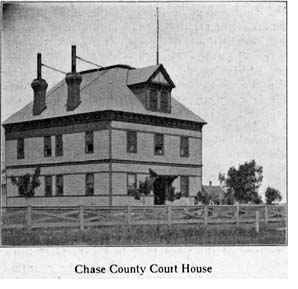|
180
|
SEMI-CENTENNIAL HISTORY OF
NEBRASKA
|
|
CHASE COUNTY.
 Chase
county is one of the newer counties, having been
organized in 1886. From the fact that it has only 18,2
miles of railroad and that it is not naturally adapted
for farming, its population is but 2,559. The soil is
mostly a dark, sandy loam and in many places very rich,
though the climate is too dry for raising grain without
the employment of artificial means. There are now over
fifty miles of irrigations and farming is being carried
on. The county is watered by Frenchman Rivers Spring
River and Sand Creek. The level river bottoms are
bordered by bluffs which are cut by many canons. These
bluffs make good grazing, as well as sheltering places
for the stock. Imperial is the county seat, with a
population of 258. There are 921 school children in the
county. Cherries, plums and peaches are successfully
cultivated here, while corn, wheat, millet, cane and
potatoes make up the principal farm produce. Land has
increased one-fifth in value in the last few years. Chase
county is one of the newer counties, having been
organized in 1886. From the fact that it has only 18,2
miles of railroad and that it is not naturally adapted
for farming, its population is but 2,559. The soil is
mostly a dark, sandy loam and in many places very rich,
though the climate is too dry for raising grain without
the employment of artificial means. There are now over
fifty miles of irrigations and farming is being carried
on. The county is watered by Frenchman Rivers Spring
River and Sand Creek. The level river bottoms are
bordered by bluffs which are cut by many canons. These
bluffs make good grazing, as well as sheltering places
for the stock. Imperial is the county seat, with a
population of 258. There are 921 school children in the
county. Cherries, plums and peaches are successfully
cultivated here, while corn, wheat, millet, cane and
potatoes make up the principal farm produce. Land has
increased one-fifth in value in the last few years.
CEDAR COUNTY.
Cedar County has
been greatly hindered in its growth by the various
calamities which have befallen it since its organization
in 1857. At first it was necessary to maintain a constant
defense against the Indians, especially the tribe of
Poncas at whose hands several murders are recorded. In
1864, at the time of the general stampede on account of
an uprising of the Indians, the inhabitants of Cedar
County built fortifications and prepared to defend
themselves. Another setback to progress was that at first
much of the land was held by non-residents and was not
open for claim settlement. The Civil War and the
grasshopper visitation were means of retarding the
growth. In later years the flood of 1881 destroyed an
immense amount of property, and in some instances the
settlers were glad to escape with their lives. The
valleys of the Antelope, Beaver and Bow Creek comprise
nearly one-half the surface of Cedar County, and in some
places these valleys are perfectly level for miles in
extent. The soil is rich and is mostly of vegetable mold.
An immense amount of chalk rock is found here which is
used in some degree for building purposes. The 716 square
miles of area are occupied by 12,467 people. Hartington,
the county seat, has a population of 971. Land has
doubled in value since 1897. The manufacturies consist of
five flour and grist mills and three brick yards.
L. J. HOILE,
County Clerk, was born in Wood County, Ohio, June 7,
1869. He removed in 1892 to Wayne, Nebraska, where he
engaged for six years in the lumber business as
travelling manager and collector. He then went to Laurel,
Nebraska as manager of a lumber yard and after a
residence of four and a half years there was elected
County Clerk. He gained his education at Prairie Depot,
Ohio in the high school. In 1897 he married Miss Ella
Pergellis and they have two children. Mr. Hoile received
231 out of 239 votes in his home town.
M. T. WOODS,
Clerk of the District Court, was born in Warren County,
Illinois, January 22, 1872. Removed with his parents to
Kansas in 1876, returned to Illinois in 1879, came to
Butler County, Nebraska in 1882, to Holt County in 1884
and settled in Cedar County in 1895. He gained his
education in the high school at Atkinson, Nebraska. In
1889 he married Miss Nellie Inez Patrick. He has held
several offices such as justice of the Peace, Street
Commissioner, City Clerk and Town Marshal.
C. H. WHITNEY,
County Attorney, was
|







